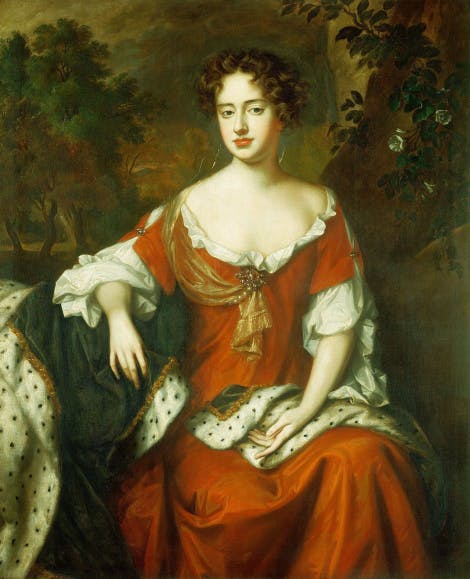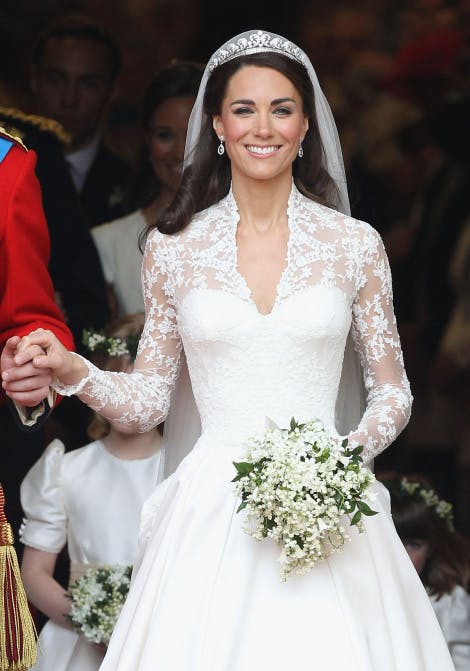Dress Codes opens 13 March 2025
Exhibition generously supported by the Blavatnik Family Foundation and Avis Charles Associates.
A host of never-before-seen royal fashion treasures are set to go on show at Kensington Palace as part of a new exhibition, Dress Codes, due to open in March 2025. Showcasing both instantly recognisable and rarely seen highlights from the Royal Ceremonial Dress Collection, the display will explore the codes and conventions of royal clothing, and the powerful impact fashion can make when boundaries are pushed and dress codes evolve. Looking through a contemporary lens at historic royal and court dress, the exhibition will reveal global connections alongside personal stories with resonance for the modern ‘dress codes’ we all follow today.
Highlights will include two matching Liberty print floral cotton dresses, worn in 1936 by Queen Elizabeth II (then Princess Elizabeth) and her younger sister Princess Margaret when they were children growing up in London, on display at Kensington Palace for the first time. The young sisters often wore matching clothes, their own distinctive dress code, and the rare survivals are a very personal example of the royal family recycling and repairing clothing. The dress worn by a young Princess Elizabeth shows signs of adaptation to accommodate a growing Princess, including altered hems and seams, and may have been passed down to her younger sister, reflecting the economical attitudes of the 1930s that favoured making things last.
Members of the Royal Family follow certain dress codes for their official duties, often using clothing to communicate messages about their roles or the causes they champion. Items of clothing worn by former royal residents of Kensington Palace will go on display, including a glittering red Bruce Oldfield gown worn by Diana, Princess of Wales for a state visit to Saudi Arabia in 1987, showcasing the importance placed on dressing correctly for official duties. Alongside this will be a Catherine Walker green silk velvet tuxedo-style dress, worn to formal family events, and then shared with the world as one of 79 dresses famously auctioned to raise money for HIV/AIDS and cancer charities in 1997.
Another Kensington Palace resident known for her style and for playing with royal fashion boundaries of the time was Princess Margaret, and Dress Codes is set to exhibit two items of dress which have never been displayed in the UK before. A 1978 Thea Porter evening ensemble will go on public display for the very first time, alongside a colourful green embroidered evening gown by the Filipino designer Jose Pitoy Moreno, worn in 1980.
The show will also feature items worn by the ultimate observer of royal dress codes, Queen Victoria, including a never-before-displayed black mourning bodice, a rare survivor from the early years following the death of Prince Albert. Queen Victoria was born at Kensington Palace in 1819 and spent her childhood there.
The exhibition will also feature clothing worn at court or on state and public occasions, and showcases some hidden treasures of the Royal Ceremonial Dress Collection. The collection, which spans 500 years of royal and court dress, is cared for by independent charity Historic Royal Palaces, and is still developing today. A recent addition has been a dress worn by Dame Vivienne Westwood when she collected her DBE for services to fashion in 2006, which will go on show for the first time since being acquired at auction in 2024. The black polka dot draped gown was one of the designer’s own creations, with a train referencing traditional court dress, but the deconstructed design and styling representing Westwood’s rule-breaking values and politics. Other items worn at historic court events will also feature, such as a never-before-seen stunning 1920s court dress, manufactured by Reville and worn by Lady Annie Holcroft to her presentation at Buckingham Palace in May 1928. The chic black and white ensemble features a dramatic train and is a notable example of 1920s style that also conformed to the dress code for women attending the royal court, as laid down by the Lord Chamberlain.
One of the great strengths of the Royal Ceremonial Dress Collection is its exceptional collection of men’s uniforms. Uniforms conform to strict codes, and some of these rarely seen examples of exceptional men’s tailoring, embellished with gold embroidery, will be showcased in the exhibition. These include an extremely rare Japanese court suit dating from the early twentieth century. Featuring gold embroidered paulownia flowers (a traditional symbol or mon of Japanese government), it demonstrates the global influence of European style diplomatic uniforms and has gone through painstaking conservation by a team of Historic Royal Palaces experts, informed by research with experts in Japan, to prepare it for display.
In a first for Historic Royal Palaces, the charity has partnered with three local youth groups, with a number of participants aged 14-17 acting as Young Producers on the exhibition. The Young Producers have been an intrinsic part of the development of the exhibition, which has included making creative responses through storytelling, fashion design and music creation, offering a contemporary perspective to the objects.
The final room will showcase clothing designed by the Young Producers, inspired by items from the Royal Ceremonial Dress Collection and showing how dress codes can be reset and re-made for today. The partnership demonstrates how the collection is an important source of inspiration, paving the way for a new generation of young people contributing to the arts and fashion industries. The works were created over a year-long collaboration between the Young Producers, fashion and music industry professionals, and Historic Royal Palaces’ experts through a series of workshops and on-site tours of the historic collections.
Matthew Storey, curator at Historic Royal Palaces, said: “It has been a pleasure to delve deep into the stores of the Royal Ceremonial Dress Collection, to share hidden treasures alongside iconic outfits. Working with the Young Producers has shown how fascinating the histories of these garments are, from the personal to the political, and how their design can inspire creativity today. Kensington Palace has always been the home of royal fashion, from court occasions in the Georgian period, to its stylish former residents, to our exhibitions today. I’m looking forward to sharing an incredible range of stunning items with our visitors, including many that have never been seen before, and celebrating the creativity of our remarkable Young Producers.”
Dress Codes opens to the public on 13 March 2025 and will run until 30 November. It is included in palace admission.
www.hrp.org.uk/kensington-palace/whats-on/dress-codes
Dress Codes has been generously supported by the Blavatnik Family Foundation and Avis Charles Associates.
Notes to Editors
For further information and images please contact Sophie Lemagnen in the Historic Royal Palaces Press Office via press@hrp.org.uk / 020 3166 6166
Tickets: Adult £24.70 / Concession £20 / Child £12.40 Free for Historic Royal Palaces members. £1 tickets are available for those in receipt of certain means-tested financial benefits.
Historic Royal Palaces is the independent charity that loves and looks after six of the most wonderful palaces in the world. The palaces are the setting for the stories that shape us all, and we’re bringing them to people in ways that mean more to them. We want everyone to find themselves in the spaces and stories we share.
Registered charity number 1068852. For more information visit www.hrp.org.uk
The Blavatnik Family Foundation supports world-renowned educational, scientific, cultural, and charitable institutions in the United States, the United Kingdom, Israel, and across the globe. Led by Sir Leonard Blavatnik, founder of Access Industries, the Foundation advances and promotes innovation, discovery, and creativity to benefit the whole of society. Over the past decade, the Foundation has contributed more than $1 billion to over 250 organizations.
For more information visit www.blavatnikfoundation.org
Avis Charles Associates is delighted to be supporting Dress Codes. In all aspects of their work, Dr Avis Ellis-Charles and her team advocate for and support young people, harnessing more than 40 years’ experience in fashion and textiles to promote equitable opportunities.
This project meets those criteria, bringing together young people to design, create and bring to life to their ideas. The young producers have surprised everyone involved in the exhibition with their creativity and ability, adding a whole new dimension to the project.
Engaging and encouraging the group to have a free rein and the confidence to explore their creative ideas, has resulted in incredible designs. Their willingness to work cross culturally, learning from each other and including their newfound skills in their work, will remain with them throughout their lives. Thus, allowing them to expand their horizons and future career aspirations.
For more information contact info@avisgcharles.com
Browse more history and stories

Queen Anne
A surprisingly successful monarch, despite ill health and tragedy

A history of royal weddings
From Queen Victoria to the modern royals
